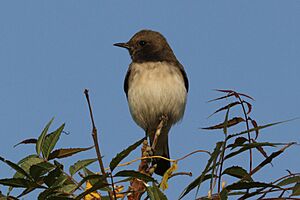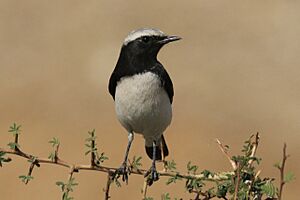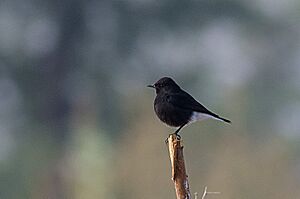Variable wheatear facts for kids
Quick facts for kids Variable wheatear |
|
|---|---|
 |
|
| Male O. p. picata | |
 |
|
| Male O. p. capistrata Both Jawai, Rajasthan, India |
|
| Conservation status | |
| Scientific classification |
The variable wheatear (Oenanthe picata) is a small bird that belongs to the thrush family, Muscicapidae. You can find this bird in many countries, including Afghanistan, Egypt, India, Iran, Kazakhstan, Lebanon, Nepal, Oman, Pakistan, Russia, Tajikistan, Turkmenistan, the United Arab Emirates, and Uzbekistan.
These birds love to live in hot, dry places like deserts. They are well-suited for life in sandy or rocky areas.
Contents
What Does the Variable Wheatear Look Like?
The variable wheatear is a bird that lives in dry and partly dry regions. You can often see many of them in rocky places, sand dunes with small bushes, or even near villages.
These birds are special because they can look very different from each other. They have three main color types, called "morphs."
Different Color Types of Variable Wheatears
Variable wheatears show amazing variety in their feathers. Here are the three main color types you might see:
Black-Bellied Wheatear (opistholeuca)
- Males: These birds are almost completely black. Their bottom (rump), the feathers under their tail, and the sides of their tail are white. The middle tail feathers and the very end of the tail are black.
- Females: The females of this type are similar to the males, but their black parts are more of a sooty (dark gray) color.
White-Bellied Wheatear (picata)
- Males: These look like the black-bellied type, but their belly is white instead of black.
- Females: Females of this type have grayish-brown feathers where the males have black. Their belly might look a bit more yellowish-brown.
White-Crowned Wheatear (capistrata)
- Males: This type is like the white-bellied wheatear, with a white belly and black throat. But what makes them stand out is their white head top (crown) and back of the neck (nape).
- Females: Females of this type have earthy brown feathers where the males have black. Their crown is also earthy brown, and their belly is often more yellowish-brown.
It's interesting that where you find these different female types doesn't always perfectly match where you find the male types. However, when they move to warmer places for winter, there is some separation in where each type settles.
Where Do Variable Wheatears Live?
This bird species lives in many places across Asia. You can find them in parts of Iran and Turkmenistan, stretching east to the Tien Shan and Pamir mountains, and into northern and western Pakistan.
When it's not breeding season, they travel to southwest Asia. They are very common in winter in Pakistan and northwestern India. They can be seen as far southeast as Delhi and parts of central India.
When Do They Arrive and Leave?
Variable wheatears usually arrive at their breeding grounds in March (in places like Baluchistan) or mid-April (in Chitral). They stay there until September. You might see them in their winter homes from early August until the end of March.
What Kind of Places Do They Like?
In winter, these birds prefer stony, semi-desert areas. They also like deserts with scattered bushes on sand dunes, farmlands, and even the edges of villages. They are often found near places where people live or where cattle are kept.
They usually live from almost sea level up to about 1,200 meters high. But sometimes, they have been seen much higher, even at 2,700 meters, even in deep snow!



